 W
WBone morphogenetic protein receptor type II or BMPR2 is a serine/threonine receptor kinase. It binds Bone morphogenetic proteins, members of the TGF beta superfamily of ligands, which are involved in paracrine signalling. BMPs are involved in a host of cellular functions including osteogenesis, cell growth and cell differentiation. Signaling in the BMP pathway begins with the binding of a BMP to the type II receptor. This causes the recruitment of a BMP type I receptor, which it phosphorylates. The Type I receptor phosphorylates an R-SMAD a transcriptional regulator.
 W
WBone morphogenetic protein 1, also known as BMP1, is a protein which in humans is encoded by the BMP1 gene. There are seven isoforms of the protein created by alternate splicing.
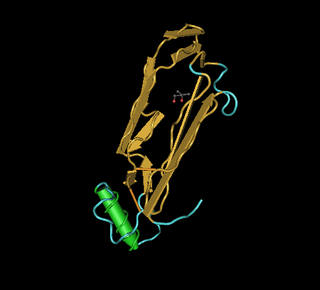 W
WBone morphogenetic protein 2 or BMP-2 belongs to the TGF-β superfamily of proteins.
 W
WBone morphogenetic protein 3, also known as osteogenin, is a protein in humans that is encoded by the BMP3 gene.
 W
WBone morphogenetic protein 4 is a protein that in humans is encoded by BMP4 gene. BMP4 is found on chromosome 14q22-q23
 W
WBone morphogenetic protein 5 is a protein that in humans is encoded by the BMP5 gene.
 W
WBone morphogenetic protein 6 is a protein that in humans is encoded by the BMP6 gene.
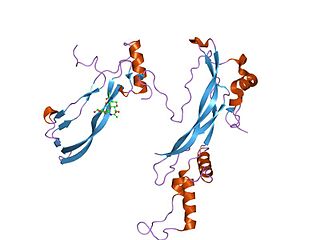 W
WBone morphogenetic protein 7 or BMP7 is a protein that in humans is encoded by the BMP7 gene.
 W
WBone morphogenetic protein 8A (BMP8A) is a protein that in humans is encoded by the BMP8A gene.
 W
WBone morphogenetic protein 8B is a protein that in humans is encoded by the BMP8B gene.
 W
WBone morphogenetic protein 10 (BMP10) is a protein that in humans is encoded by the BMP10 gene.
 W
WBone morphogenetic protein 15 (BMP-15) is a protein that in humans is encoded by the BMP15 gene. It is involved in folliculogenesis, the process in which primordial follicles develop into pre-ovulatory follicles.
 W
WDoublesex (dsx) is a gene that is involved in the sex determination system of many insects including the fruit fly Drosophila melanogaster.
 W
WA gap gene is a type of gene involved in the development of the segmented embryos of some arthropods. Gap genes are defined by the effect of a mutation in that gene, which causes the loss of contiguous body segments, resembling a gap in the normal body plan. Each gap gene, therefore, is necessary for the development of a section of the organism.
 W
WGrowth differentiation factor 1 (GDF1) is a protein that in humans is encoded by the GDF1 gene.
 W
WGrowth differentiation factor 2 (GDF2) also known as bone morphogenetic protein (BMP)-9 is a protein that in humans is encoded by the GDF2 gene. GDF2 belongs to the transforming growth factor beta superfamily.
 W
WGrowth differentiation factor-3 (GDF3), also known as Vg-related gene 2 (Vgr-2) is protein that in humans is encoded by the GDF3 gene. GDF3 belongs to the transforming growth factor beta (TGF-β) superfamily. It has high similarity to other TGF-β superfamily members including Vg1 and GDF1.
 W
WGrowth/differentiation factor 5 is a protein that in humans is encoded by the GDF5 gene.
 W
WGrowth differentiation factor 6 (GDF6) is a protein that in humans is encoded by the GDF6 gene.
 W
WGrowth differentiation factor 7 (GDF7) is a protein that in humans is encoded by the GDF7 gene.
 W
WGrowth differentiation factor 10 (GDF10) also known as bone morphogenetic protein 3B (BMP-3B) is a protein that in humans is encoded by the GDF10 gene.
 W
WGrowth differentiation factor 11 (GDF11) also known as bone morphogenetic protein 11 (BMP-11) is a protein that in humans is encoded by the growth differentiation factor 11 gene. GDF11 is a member of the Transforming growth factor beta family.
 W
WGrowth/differentiation factor 15 (GDF15) was first identified as Macrophage inhibitory cytokine-1 or MIC-1.
 W
WThe halloween genes are a set of genes identified in Drosophila melanogaster that influence embryonic development. All of the genes code for cytochrome P450 enzymes in the ecdysteroidogenic pathway (biosynthesis of ecdysone from cholesterol). Ecdysteroids such as 20-hydroxyecdysone and ecdysone influence many of the morphological, physiological, biochemical changes that occur during molting in insects.
 W
WHepatocyte growth factor (HGF) or scatter factor (SF) is a paracrine cellular growth, motility and morphogenic factor. It is secreted by mesenchymal cells and targets and acts primarily upon epithelial cells and endothelial cells, but also acts on haemopoietic progenitor cells and T cells. It has been shown to have a major role in embryonic organ development, specifically in myogenesis, in adult organ regeneration, and in wound healing.
 W
WHox genes play a massive role in some amphibians and reptiles in their ability to regenerate lost limbs, especially HoxA and HoxD genes.
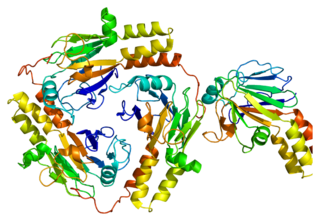 W
WMothers against decapentaplegic homolog 1 also known as SMAD family member 1 or SMAD1 is a protein that in humans is encoded by the SMAD1 gene.
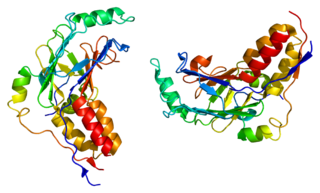 W
WMothers against decapentaplegic homolog 2 also known as SMAD family member 2 or SMAD2 is a protein that in humans is encoded by the SMAD2 gene. MAD homolog 2 belongs to the SMAD, a family of proteins similar to the gene products of the Drosophila gene 'mothers against decapentaplegic' (Mad) and the C. elegans gene Sma. SMAD proteins are signal transducers and transcriptional modulators that mediate multiple signaling pathways.
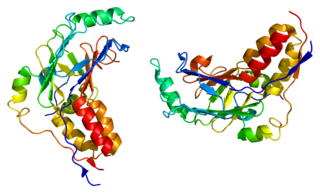 W
WMothers against decapentaplegic homolog 3 also known as SMAD family member 3 or SMAD3 is a protein that in humans is encoded by the SMAD3 gene.
 W
WSMAD4, also called SMAD family member 4, Mothers against decapentaplegic homolog 4, or DPC4 is a highly conserved protein present in all metazoans. It belongs to the SMAD family of transcription factor proteins, which act as mediators of TGF-β signal transduction. The TGFβ family of cytokines regulates critical processes during the lifecycle of metazoans, with important roles during embryo development, tissue homeostasis, regeneration, and immune regulation.
 W
WMothers against decapentaplegic homolog 5 also known as SMAD5 is a protein that in humans is encoded by the SMAD5 gene.
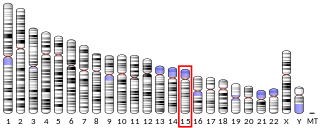 W
WSMAD family member 6, also known as SMAD6, is a protein that in humans is encoded by the SMAD6 gene.
 W
WMothers against decapentaplegic homolog 7 or SMAD7 is a protein that in humans is encoded by the SMAD7 gene.
 W
WMothers against decapentaplegic homolog 9 also known as SMAD9, SMAD8, and MADH6 is a protein that in humans is encoded by the SMAD9 gene.
 W
WNodal is a secretory protein that in humans is encoded by the NODAL gene which is located on chromosome 10q22.1. It belongs to the transforming growth factor beta (TGF-β) superfamily. Like many other members of this superfamily it is involved in cell differentiation in early embryogenesis, playing a key role in signal transfer from the node, in the anterior primitive streak, to lateral plate mesoderm (LPM).
 W
WNoggin, also known as NOG, is a protein that is involved in the development of many body tissues, including nerve tissue, muscles, and bones. In humans, noggin is encoded by the NOG gene. The amino acid sequence of human noggin is highly homologous to that of rat, mouse, and Xenopus.
 W
WA pair-rule gene is a type of gene involved in the development of the segmented embryos of insects. Pair-rule genes are expressed as a result of differing concentrations of gap gene proteins, which encode transcription factors controlling pair-rule gene expression. Pair-rule genes are defined by the effect of a mutation in that gene, which causes the loss of the normal developmental pattern in alternating segments.
 W
WIn evolutionary developmental biology, Paired box (Pax) genes are a family of genes coding for tissue specific transcription factors containing an N-terminal paired domain and usually a partial, or in the case of four family members, a complete homeodomain to the C-terminus. An octapeptide as well as a Pro-Ser-Thr-rich C terminus may also be present. Pax proteins are important in early animal development for the specification of specific tissues, as well as during epimorphic limb regeneration in animals capable of such.
 W
WThe PAX3 gene encodes a member of the paired box or PAX family of transcription factors. The PAX family consists of nine human (PAX1-PAX9) and nine mouse (Pax1-Pax9) members arranged into four subfamilies. Human PAX3 and mouse Pax3 are present in a subfamily along with the highly homologous human PAX7 and mouse Pax7 genes. The human PAX3 gene is located in the 2q36.1 chromosomal region, and contains 10 exons within a 100 kb region.
 W
WPaired box protein Pax-6, also known as aniridia type II protein (AN2) or oculorhombin, is a protein that in humans is encoded by the PAX6 gene.
 W
WSOX1 is a gene that encodes a transcription factor with a HMG-box DNA-binding domain and functions primarily in neurogenesis. SOX1, SOX2 and SOX3, members of the SOX gene family, contain transcription factors related to SRY, the testis-determining factor.
 W
WSLIT-ROBO Rho GTPase-activating protein 2 (srGAP2), also known as formin-binding protein 2 (FNBP2), is a mammalian protein that in humans is encoded by the SRGAP2 gene. It is involved in neuronal migration and differentiation and plays a critical role in synaptic development, brain mass and number of cortical neurons. Downregulation of srGAP2 inhibits cell–cell repulsion and enhances cell–cell contact duration.
 W
WThyroxine 5-deiodinase also known as type III iodothyronine deiodinase (EC number 1.21.99.3) is an enzyme that in humans is encoded by the DIO3 gene. This enzyme catalyses the following chemical reaction3,3',5'-triiodo-L-thyronine + iodide + A + H+ L-thyroxine + AH2
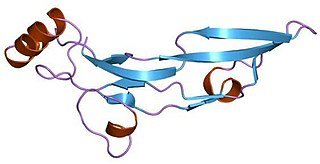 W
WThe transforming growth factor beta (TGF-β) family is a large group of structurally related cell regulatory proteins that was named after its first member, TGF-β1, originally described in 1983. They interact with TGF-beta receptors.
 W
WPDX1, also known as insulin promoter factor 1, is a transcription factor in the ParaHox gene cluster. In vertebrates, Pdx1 is necessary for pancreatic development, including β-cell maturation, and duodenal differentiation. In humans this protein is encoded by the PDX1 gene, which was formerly known as IPF1. The gene was originally identified in the clawed frog Xenopus laevis and is present widely across the evolutionary diversity of bilaterian animals, although it has been lost in evolution in arthropods and nematodes. Despite the gene name being Pdx1, there is no Pdx2 gene in most animals; single-copy Pdx1 orthologs have been identified in all mammals. Coelacanth and cartilaginous fish are, so far, the only vertebrates shown to have two Pdx genes, Pdx1 and Pdx2.
 W
WZinc finger FYVE domain-containing protein 9 or SARA is a protein that in humans is encoded by the ZFYVE9 gene. SARA contains a double zinc finger.